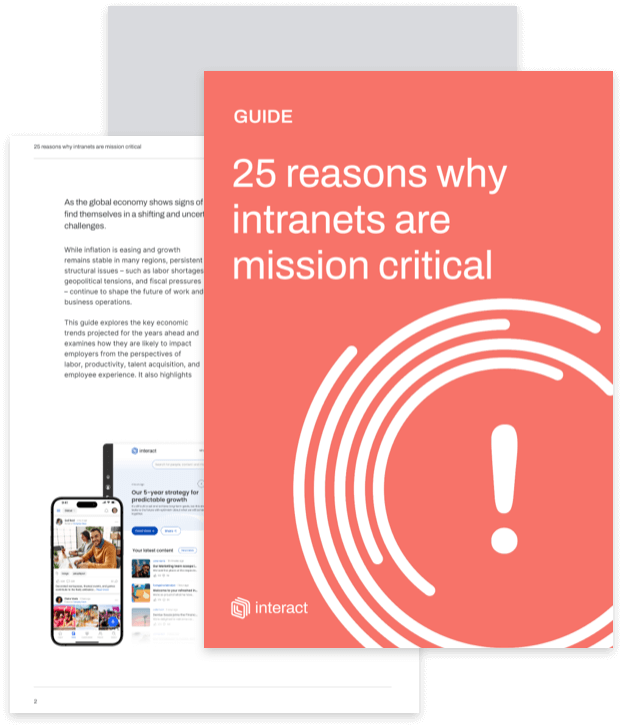Discover what the future of internal communications is likely to look like, and how your comms team can prepare for the changes ahead.
Advances in technology, the rise of remote work, and shifting employee expectations about corporate values and culture are all contributing to rapid changes in the nature of work.
These seismic shifts aren’t just affecting workers either but the organizations themselves. Companies have already had to change how they recruit and retain staff, moving from a model of employee engagement to one of holistic employee experience.
How organizations approach internal communication is central to this too. In order to maintain happy, productive workplaces, organizations must look to the future of internal communications, adapting and embracing new strategies and tools for effective communication.
Key workplace changes shaping the future of internal communications

It’s hard to keep up with everything that’s changed in recent times, so this article takes a look at some of the key trends shaping the future of internal communication and explores the ways organizations can respond.
The impact of the pandemic will run on…and on, and on
By now we’re all a little tired of hearing about the pandemic and its impacts, especially those prefixed with the word ‘great’ (The Great Resignation, The Great Reshuffle, The Great Relocation).
However, some effects of the pandemic will continue to reshape the business landscape and the future of internal communications for years to come:
- The Great Resignation will persist, with Gartner predicting that misaligned expectations between leaders and employees will keep driving employee turnover.
- Employers will continue to struggle with filling vacancies created by The Great Reshuffle. More than half of workers changed careers entirely during the pandemic, according to Pew Research.
- The Great Retirement described the exit of many baby boomers from the workforce as a result of the pandemic. Economists predict the resulting labor shortages could last for at least a decade, with some countries now incentivizing older people to re-join the workforce.
This matters for enterprises and their comms teams because it will mean a continued need to highlight content that engages and retains workers. Whether it’s increasing your quarterly focus on L&D programs or helping to rebalance organizational alignment, the pandemic’s after effects will live on.
New generations will bring new expectations
When it comes to the generations that make up the workforce, Gen Z (those born between 1997 and 2012) are still very much the new kids on the block, but by 2025 they will represent 27% of the workforce in OECD countries.
Organizations will need to fully understand their needs to ensure Gen-Z workers get the employee experience they expect.
Some of the common traits to bear in mind when communicating with Gen-Z employees include:
- Gen-Z employees prefer a collaborative approach to communication, where they are involved in discussions and given the freedom to express their ideas.
- As digital natives, Gen-Z employees are more comfortable communicating through instant messaging platforms and digital workplace software with social features, and often prefer to consume information in bite-sized chunks.
- Transparency in communication is important to Gen-Z workers. They expect their managers to be honest and upfront about company goals and challenges.
Is your intranet mission critical?
In short, the days of all-company emails are over. New communications and production skills will be needed for new audiences.
It’s also worthwhile exploring how to communicate effectively with Generation Alpha, who will follow Gen Z. At this early stage, it looks as though Alpha’s needs will be harder to define, or they are at least more resistant to being defined; a recent Fast Company article titled ‘I’m Gen Alpha, and I think adult marketers should stop trying so hard to define us’ heralds a bucking of easy generational tropes.
The most effective way to understand any generation and its workplace expectations is through authentic two-way communications, employee surveys, and a social intranet platform that facilitates social listening and collaboration.
Mental health and wellbeing needs will change
Mental health and holistic wellbeing needs to be taken as seriously as physical health.
This has already been recognized by progressive employers with proactive programs, but we are only really at the beginning of this journey towards better mental health support at work. New needs will continue to arise, meaning the support employers offer must also continue to evolve.
For example, the long-term impact that lockdowns have had on our collective mental health will take some time to measure, while generational differences in coping with stress are another factor that will need to be addressed.
Recent research suggests that Gen Z is the most stressed generation in the workplace, with factors such as job insecurity, financial concerns, and unrealistic work expectations contributing to anxiety and burnout.
The continued comms focus on mental health may demand that sensitivity, empathy, and personal coaching all become even more valuable skills for internal communicators in coming years.
DE&I will evolve in several ways
Much is being done to promote DE&I, but as workplaces become increasingly diverse and globalized, DE&I programs are likely to evolve too:
- DE&I programs may place greater emphasis on intersectionality, recognizing that individuals have multiple identities and experiences that impact their working lives. This means taking a more holistic approach to DE&I that considers the connectedness of factors such as race, gender, sexuality, ability, and socio-economic status. There has been a focus on these factors in isolation (single-identity ERGs, for example), but they will coalesce into something more connected.
- Data will play a greater role in DE&I, with a focus on collecting and analyzing data to track progress and identify areas for improvement. This could include measuring representation, retention rates, and employee satisfaction surveys.
- Future DE&I programs may also take a more holistic approach that considers the entire employee experience, from recruitment and onboarding to training, development, and leadership opportunities. How should your enterprise get underrepresented people to apply in the first place and then how are they supported at every stage of the employee lifecycle?
- Collaboration and mentorship will become increasingly important, with a focus on engaging employees at all levels and working across departments and teams to create a more inclusive workplace culture.
Reskilling and upskilling will become more common
The rise of automation and AI will change the nature of work, and it’s likely that many employees will need to acquire new skills to adapt to these changes.
For example, employees who previously performed tasks that can be automated may need to learn new skills to work with the technology that is replacing them. Similarly, employees whose jobs may be augmented by AI may need to learn how to work alongside these systems and leverage their capabilities.
Marketing is one area that is already undergoing transformation thanks to AI. Marketers who master the creation of “prompts” will be better able to leverage tools such as ChatGPT and Bard for content creation, copywriting, emails, A/B testing, SEO optimization, and graphic design. Even if the tools simply enhance human output, they may still save time and allow marketing teams to focus on other areas.
Is your intranet mission critical?
Organizations will need to provide opportunities for employees to learn new skills and retrain for new roles, which may involve providing access to training programs, offering mentorship and coaching, or even providing financial support for employees to pursue education and training outside of work.
Reskilling is not only important for the continued success of the organization, but it’s also crucial for employee wellbeing, providing new opportunities and helping them stay relevant in the ever-changing digital workplace.
For communicators too, having a rounded skillset may mean placing a greater personal focus on learning how to work with video, design, internal branding, and code, especially where knowing code languages will help you to adjust or alter intranet design.
Preparing for the future of internal communications
Given the changing landscape, how should enterprises prepare for future challenges and ensure they continue to communicate effectively as the workplace evolves?
1. Stay informed: Work will continue to change rapidly, so internal communicators need to stay up to date with the latest developments and trends. We recommend reading industry publications and newsletters (such as the IC Roundup), downloading internal communications resources, attending conferences, and participating in relevant online communities.
2. Communicate effectively: This may seem a little obvious, but bear with me. Internal communicators should develop clear and concise messaging that helps employees understand the changes in the future of work and how they will be affected. The messaging you have already developed may work well for here and now, but it may need to be adapted for new scenarios and new generations.
And if you’re not already doing so, it’s important to ensure you use a variety of communication channels that are most effective for each individual and their role. This should include email, your company intranet, instant messaging platforms such as Teams and Slack, digital signage, and your employee app.
3. Provide resources: Employees will need resources to help them adapt to the changes in the future of work. Internal communicators should work with HR and other departments to provide training and development opportunities, as well as resources such as job aids, tutorials, and other materials that can help employees develop the skills they need.
These resources need to be as easy as possible for employees to find, and best practice is to have a modern intranet with a powerful search function that integrates with document management systems such as SharePoint, Box, and Google Drive.
4. Encourage dialogue: Employees should be encouraged to share their thoughts and concerns about how the organization and the work they are asked to do are changing. Internal communicators can create opportunities for employees to share feedback and ideas through Town Halls and All Hands meetings, surveys, and feedback sessions.
A social intranet is a great way to empower employee voices, allowing people to start their own conversations through homepage feed posts and blogs, and contribute to conversations by leaving comments. These measures will help to build trust and transparency for employees.
Are you ready for the future?
While the insights in this article are backed by current trends, data, and research, there’s no knowing what’s around the corner. However, organizations can prepare for the future – whatever it looks like – by engaging with the wider internal communications community through events, staying up to date with the latest resources, and having a centralized intranet in place that provides the flexibility to communicate effectively in any situation.


